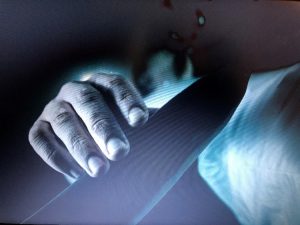Gore Verbinski’s A Cure for Wellness uses the symbolic imagery of eels in this psychological horror film. The scenes in which they feature are some of the most perturbed, which disgusts both the audience and our protagonist, Lockhart. The horror comes as a result of psychoanalytic concern about sexuality; the marrying of sexual desire and these creatures creates an unsettling encounter as the phallus is represented as malevolent slippery eels. They are a dark and uncontrollable element that evokes fear, not an animal we often encounter, but one we all recognise. This completely alien animal we come to associate with male sexuality uncomfortably brings to the forefront unconscious feelings, thoughts and desires we may have in regard to a deviant sexuality.


Verbinski sexualises the scene when two of the spa workers engage in an frank yet removed display of sexual activity. With no dialogue, the male worker masturbates from afar as the woman exposes herself (Fig. 1). The sex is detached and based on a premise of sexual fantasy rather than intimacy. This sexual deviance is mirrored as an eel passes Lockhart’s hand (Fig. 2) in a particularly phallic image, linking the two. This mixture of sex and horror is a classic combination, interlocked in a relationship that is seemingly opposing, though are arguably closely related.
What the eels achieve, here, is this: disgust is often deadened by sexual desire, the boundary between the two is ambiguous, and although the eels breach that for the audience and Lockhart in this scene, the continued sexuality of the two characters on screen creates this conflict between the two binaries. The interjected shots of Hannah, her hair flowing whilst submerged in water, who is the subject of sexual desire to Lockhart, brings this conflict to the fore for the audience. Her representation is certainly fetishised, though her actual character is completely innocent. The eels are present in later scene, a dream of Lockhart’s in which Hannah lays naked in a bath of what he discovers are eels (Fig. 3). Her obvious beauty staunchly contrasts the setting, but in this debate between disgust and sexual desire, Verbinski’s impeccable set design and direction presents Hannah in a light so that male-scopophilic sexual desire wins, despite being in a sinister way. The visuals are minimal and clean whilst adhering to a subdued colour palette creating a surreal scene that detracts from the horror, whilst successfully objectifying Hannah. Her eyes, lips, hands and hips are shot in a fetishistic manner.

The overarching theme of purity is intrinsic to this film, primarily commenting on the fragility of female sexuality. She becomes subject to a horrific, animalistic writhing as soon as her loss of innocence is inferred. This bears many parallels to the age-old Medusa myth, as she is punished for her rape at the hands of Poseidon with a head of snakes for hair, notably similar to the eels in A Cure for Wellness. This image can also be traced back to Maori (and other South Pacific cultures) mythology concerning phallic symbolism, as described in this University of Wellington article: ‘The myth of an eel (tuna) tickling a woman with its tail while she was bathing has also been regarded as evidence of phallic worship.’[1] The fetishization of physically phallic animals has a long history in the occults, suggesting a tendency for representations of sexuality to revert back to nature. Its appearance in this 2016 film is interesting as the arcane imagery insinuates fetishist excitement into the text for a late audience, a sort of re-presenting of these original myths in a new fashion.
In this way, we can see the multi-layered symbolism of the eels. We learn that they are key to the essence of immortality, the bringers of life, another hint to them as sexual organs. Yet, they serve a dark and evil purpose, to bring life they must take it, and their representation reiterates this to the fullest extent.
Reference List
[1] Te Rangi Hiroa, ‘The Coming of the Maori’, http://nzetc.victoria.ac.nz/tm/scholarly/tei-BucTheC-t1-g1-t4-body1-d5-d2.html [accessed 05/11/2020]
Bibliography
[1] Te Rangi Hiroa, ‘The Coming of the Maori’, http://nzetc.victoria.ac.nz/tm/scholarly/tei-BucTheC-t1-g1-t4-body1-d5-d2.html [accessed 05/11/2020]